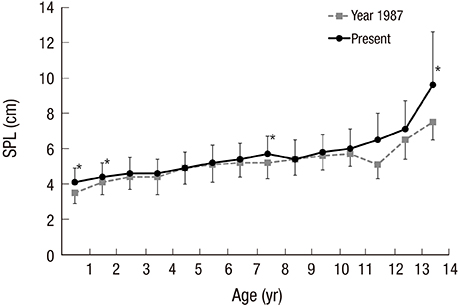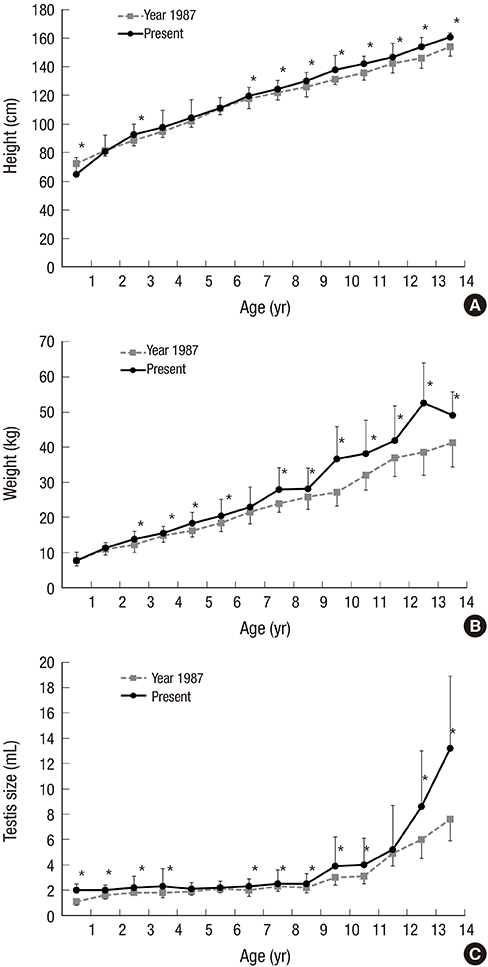J Korean Med Sci.
2016 Oct;31(10):1631-1634. 10.3346/jkms.2016.31.10.1631.
The Change of Stretched Penile Length and Anthropometric Data in Korean Children Aged 0-14 Years: Comparative Study of Last 25 Years
- Affiliations
-
- 1Department of Urology, University of Ulsan College of Medicine, Ulsan University Hospital, Ulsan, Korea.
- 2School of Life Sciences, Ulsan National Institute of Science and Technology, Ulsan, Korea.
- 3Department of Urology, Pusan National University Yangsan Hospital and Research Institute for Convergence of Biomedical Science and Technology, Yangsan, Korea. lsd@pusan.ac.kr
- 4Department of Urology, Inje University Busan Paik Hospital, Busan, Korea.
- 5Department of Urology, Samsung Changwon Hospital, Sungkyunkwan University School of Medicine, Changwon, Korea.
- 6Department of Urology, Dong-A University Hospital, Busan, Korea.
- KMID: 2468255
- DOI: http://doi.org/10.3346/jkms.2016.31.10.1631
Abstract
- There has been a great improvement in height and weight of Korean children owing to economic development over the last 25 years. This study aimed to evaluate the penile length of Korean children today and to compare it with a previous Korean study reported in 1987. The cross-sectional study was conducted with 909 Korean boys aged 0-14 years who had been brought to outpatient clinics of five tertiary hospitals (Busan, Ulsan, and Changwon) between September 2013 and May 2015. The stretched penile length (SPL) was measured and the testicular size was measured using orchidometry (mL). Student's t-test or Mann-Whitney U test was used to compare the result of our study and the study reported in 1987. SPL of Korean children gradually increased from 4.1 ± 0.8 cm at 0-1 year old to 9.6 ± 3.0 cm at 13-14 years old, the most rapidly during the age of 13. While body weight and testicular size significantly increased from 1987 in most of age groups, there were no significant changes in SPL although there was in some age groups. Height decreased in the infants < 1 year old and increased in the children > 6 years old. With the great economic development over the last quarter century in Korea, height, body weight, and testicular size of children significantly increased but there was no significant change in SPL except penile growth pattern.
Keyword
MeSH Terms
Figure
Cited by 1 articles
-
Comparison of penile length at 6–24 months between children with unilateral cryptorchidism and a healthy normal cohort
Dong Soo Ryu, Won Yeol Cho, Jae Min Chung, Dong Il Kang, Sang Don Lee, Sungchan Park
Investig Clin Urol. 2018;59(1):55-60. doi: 10.4111/icu.2018.59.1.55.
Reference
-
1. Reilly JM, Woodhouse CR. Small penis and the male sexual role. J Urol. 1989; 142:569–571.2. Wiygul J, Palmer LS. Micropenis. ScientificWorldJournal. 2011; 11:1462–1469.3. Tsang S. When size matters: a clinical review of pathological micropenis. J Pediatr Health Care. 2010; 24:231–240.4. Kim KS, Han J. Reconstructive surgery for intersex and micropenis. J Korean Soc Pediatr Endocrinol. 2009; 14:1–10.5. Phillip M, De Boer C, Pilpel D, Karplus M, Sofer S. Clitoral and penile sizes of full term newborns in two different ethnic groups. J Pediatr Endocrinol Metab. 1996; 9:175–179.6. Chung KH, Choi H, Kim SW. Penile and testicular sizes of Korean children. Korean J Urol. 1987; 28:255–258.7. Lee JH, Ji YH, Lee SK, Hwang HH, Ryu DS, Kim KS, Choo HS, Park S, Moon KH, Cheon SH, et al. Change in penile length in children: preliminary study. Korean J Urol. 2012; 53:870–874.8. Park JY, Lim G, Oh KW, Ryu DS, Park S, Jeon JC, Cheon SH, Moon KH, Park S, Park S. Penile length, digit length, and anogenital distance according to birth weight in newborn male infants. Korean J Urol. 2015; 56:248–253.9. Lee PA, Danish RK, Mazur T, Migeon CJ, Micropenis II. Primary hypogonadism, partial androgen insensitivity syndrome, and idiopathic disorders. Johns Hopkins Med J. 1980; 147:175–181.10. Khan S, Somani B, Lam W, Donat R. Establishing a reference range for penile length in Caucasian British men: a prospective study of 609 men. BJU Int. 2012; 109:740–744.11. Ishii T, Matsuo N, Inokuchi M, Hasegawa T. A cross-sectional growth reference and chart of stretched penile length for Japanese boys aged 0-7 years. Horm Res Paediatr. 2014; 82:388–393.12. Matsuo N, Ishii T, Takayama JI, Miwa M, Hasegawa T. Reference standard of penile size and prevalence of buried penis in Japanese newborn male infants. Endocr J. 2014; 61:849–853.13. Habous M, Muir G, Tealab A, Williamson B, Elkhouly M, Elhadek W, Mahmoud S, Laban O, Binsaleh S, Abdelwahab O, et al. Analysis of the interobserver variability in penile length assessment. J Sex Med. 2015; 12:2031–2035.14. Guo LL, Tang DX. Measurement of penile length in children and its significance. Zhonghua Nan Ke Xue. 2013; 19:835–840.15. Hatipoğlu N, Kurtoğlu S. Micropenis: etiology, diagnosis and treatment approaches. J Clin Res Pediatr Endocrinol. 2013; 5:217–223.16. Tomova A, Deepinder F, Robeva R, Lalabonova H, Kumanov P, Agarwal A. Growth and development of male external genitalia: a cross-sectional study of 6200 males aged 0 to 19 years. Arch Pediatr Adolesc Med. 2010; 164:1152–1157.17. Gabrich PN, Vasconcelos JS, Damião R, Silva EA. Penile anthropometry in Brazilian children and adolescents. J Pediatr (Rio J). 2007; 83:441–446.18. Camurdan AD, Oz MO, Ilhan MN, Camurdan OM, Sahin F, Beyazova U. Current stretched penile length: cross-sectional study of 1040 healthy Turkish children aged 0 to 5 years. Urology. 2007; 70:572–575.19. Teckchandani N, Bajpai M. Penile length nomogram for Asian Indian prepubertal boys. J Pediatr Urol. 2014; 10:352–354.20. Cinaz P, Yeşilkaya E, Onganlar YH, Boyraz M, Bideci A, Camurdan O, Karaoğlu AB. Penile anthropometry of normal prepubertal boys in Turkey. Acta Paediatr. 2012; 101:e33–6.21. Boas M, Boisen KA, Virtanen HE, Kaleva M, Suomi AM, Schmidt IM, Damgaard IN, Kai CM, Chellakooty M, Skakkebaek NE, et al. Postnatal penile length and growth rate correlate to serum testosterone levels: a longitudinal study of 1962 normal boys. Eur J Endocrinol. 2006; 154:125–129.
- Full Text Links
- Actions
-
Cited
- CITED
-
- Close
- Share
- Similar articles
-
- Penile circumference and stretched penile length in prepubertal children: A retrospective, single-center pilot study
- Penile and Testicular Sizes of Korean Children
- Study on Penile Length of Korean Young Adults with or without Circumcision
- Change in Penile Length in Children: Preliminary Study
- Normal Penile Size and Self Esteem about Penile Size of the Third Decade Men in Korea



